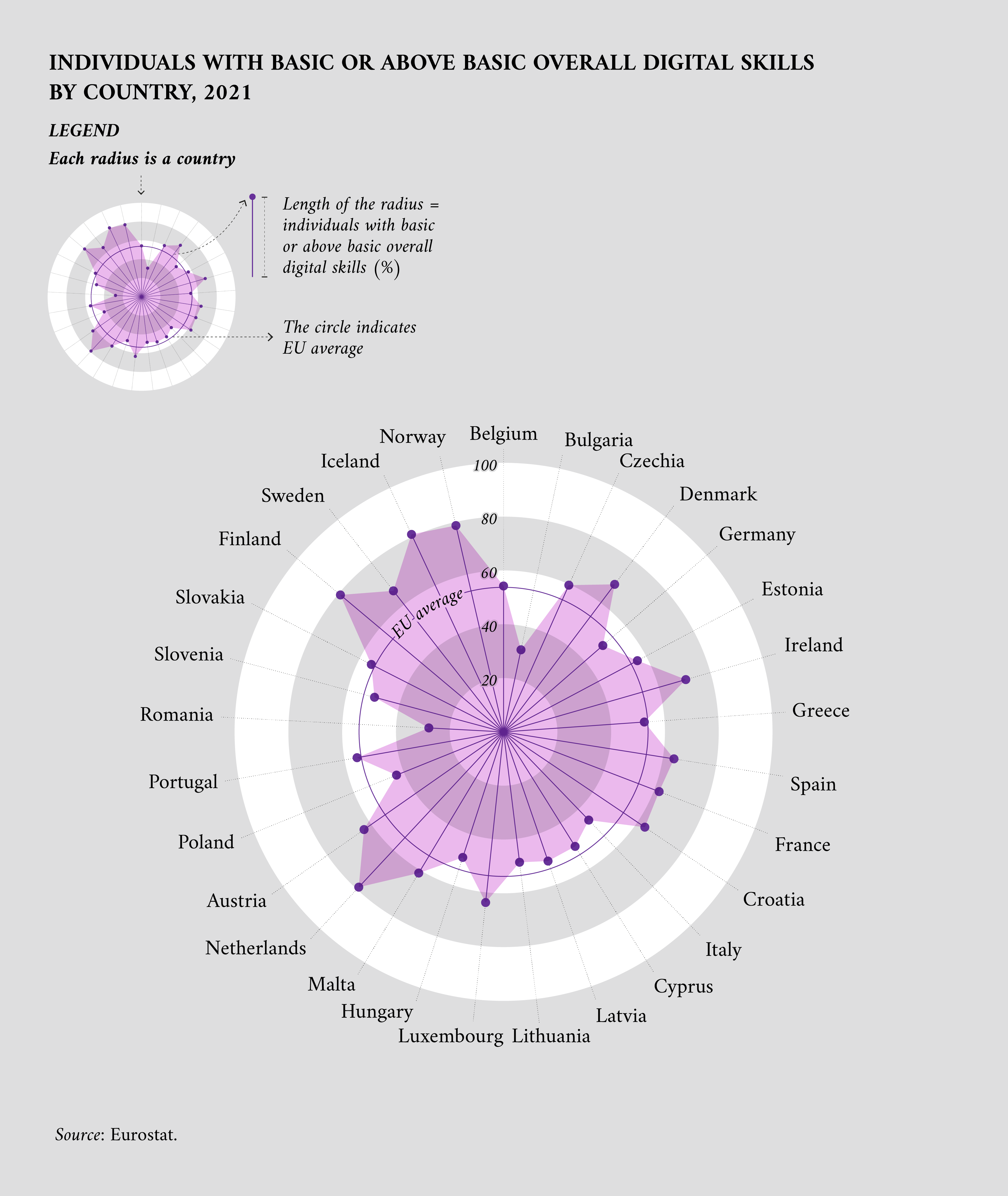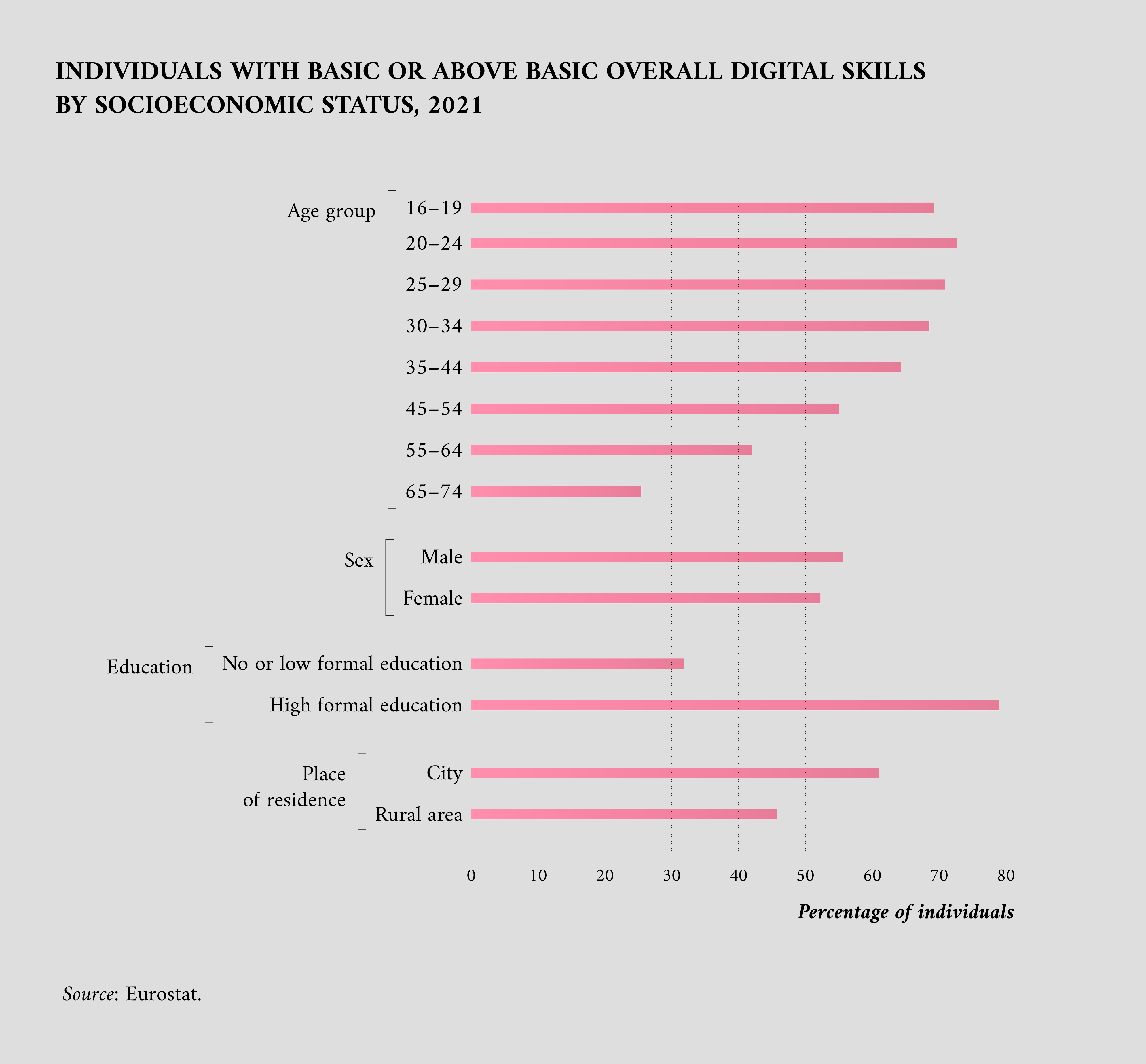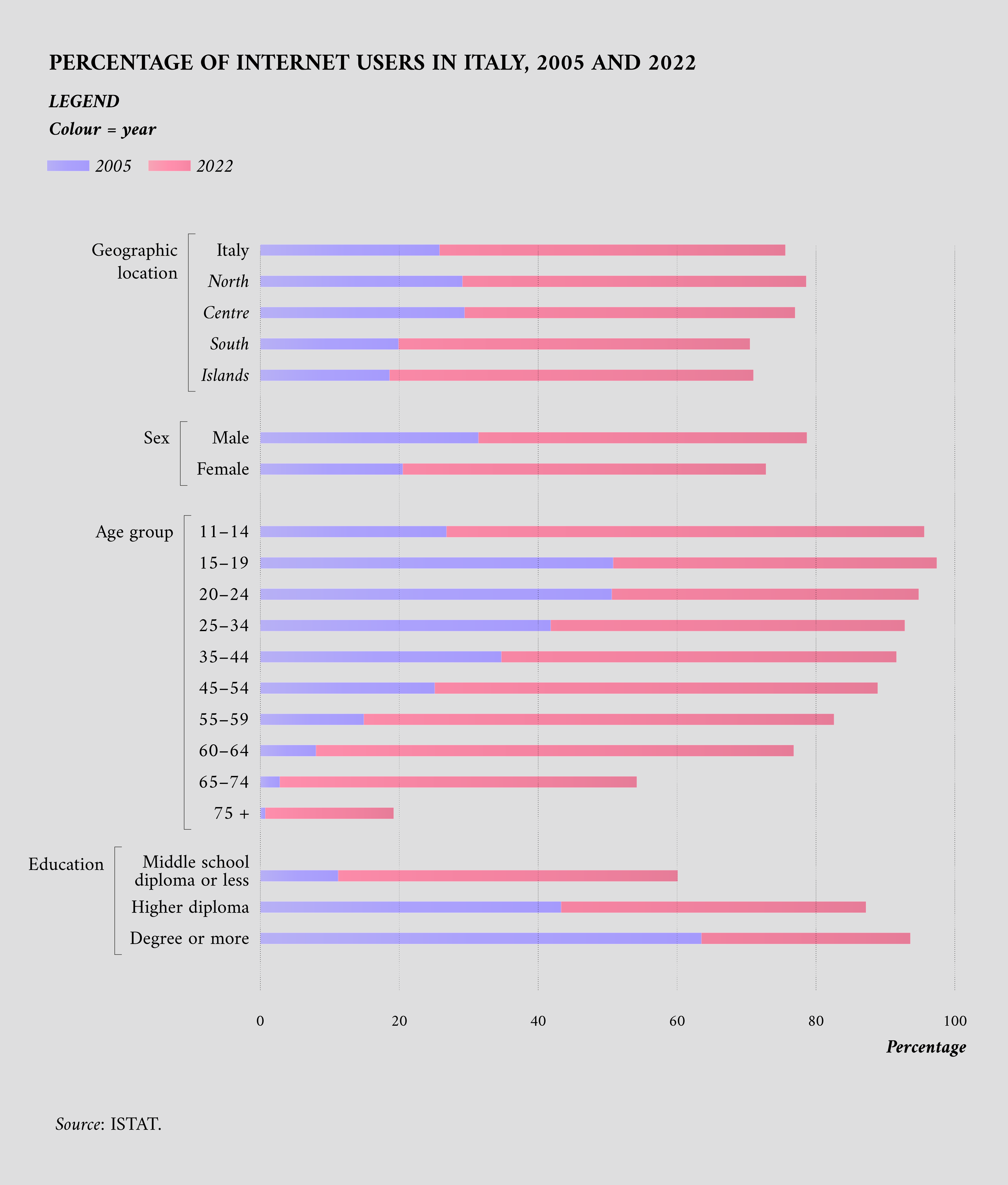Digital literacy in the EU: An overview
Measuring and improving digital proficiency through data
Digital skills are becoming increasingly essential for both personal and professional life. Currently, more than 90 % of jobs in Europe require basic digital knowledge alongside traditional skills like literacy and numeracy. However, approximately 32 % of Europeans still lack basic digital skills.
Given the pervasive role of digital technology in sectors ranging from business to transport to agriculture, there is a growing emphasis on the importance of measuring and enhancing digital skills across the EU.
To address the digital skills gap, the EU has implemented a variety of policies and initiatives, such as the European skills agenda, the digital education action plan and the Digital Skills and Jobs Coalition.
Using Eurostat data to measure digital skills
To be improved, digital skills have to be measured. One of the most comprehensive attempts to quantify the digital skills of EU citizens is made by Eurostat, which provides several datasets about digital skills that cover topics related to ICT in terms of the number of users, specialists and training initiatives.
One of the key tools derived from these datasets is the Digital Skills Indicator 2.0 (DSI), which is a measure of digital competence. As mentioned in its metadata, the DSI is based on selected activities related to internet or software use that individuals aged 16 to 74 perform in five specific areas: information and data literacy, communication and collaboration, digital content creation, safety and problem solving. For each of the five areas, two levels of skills are computed that result in a score of ‘basic’ or ‘above basic’. Therefore, the DSI is an aggregated measure of how many people have a certain level of digital competence out of the total.
When looking at the individual level of those skills, it is possible to map them on several dimensions. One very important dimension is geography: how do digital skills change across the EU Member States? The following visualisation shows the share of individuals with basic or above basic digital skills in Member States as of 2021. Data suggests a significant variation between Member States, ranging from 30 % to 80 % of inhabitants having at least basic digital skills.

This Eurostat data can be further disaggregated by socioeconomic indicators, including age, gender, education and income. By doing so, policymakers and researchers can set up more targeted interventions and tailored solutions. For example, if the data reveals that people living in rural areas have significantly lower levels of digital skills compared to those living in cities, initiatives could be tailored to improve digital education among the latter.
Additionally, examining Eurostat data through the lens of gender, education and income levels can provide a nuanced understanding of inequalities within the digital realm. Correlations between educational attainment and digital skills can help educational institutions incorporate digital literacy into curricula from an early stage, bridging gaps that might otherwise widen over time.
The following visualisation highlights how many individuals in the whole of the EU have a basic or above basic level of digital skills, depending on their age group, sex, level of education and place of residence.

Age seems to be a significant factor, with a clear trend showing higher digital skills in younger age groups and a decline as age increases. There is a slight gender gap, as there are slightly more men with basic digital skills than women in the 16 to 74 age range. Education level is a strong indicator of digital skills, where among individuals with higher formal education, there is a much higher percentage with digital skills compared to those with no or low formal education. Place of residence also plays a role: more individuals living in cities have at least basic digital skills than those in rural areas.
Using national data to understand digital skills
Eurostat offers a wealth of data for those looking to understand trends concerning digital skills across the EU. However, the richness of this information is further complemented by resources found in national open data portals. Most Member States collect and publish a vast array of data on various aspects of digital literacy.
A prime example is Italy’s National Institute of Statistics (ISTAT), which publishes the ‘Equitable and sustainable well-being’ report. The report presents a comprehensive picture of societal well-being across 12 dimensions deemed relevant for its measurement. This framework, which was initiated in 2010 by ISTAT in collaboration with the National Council for Economics and Labour, incorporates an extensive suite of 152 indicators. They include indicators on the digital skills of Italian citizens, such as the proportion of regular internet users, the availability of personal computers, households with an internet connection and so on. The report is published annually, and the indicators are updated with the same frequency.
The following visualisation shows how many people in Italy were regular internet users in 2005 and 2022 (the first and last years for which the information is available). ISTAT’s data also allows users to understand which social groups are more active internet users, including people in the centre or north of the country, younger individuals and more educated individuals.

Between 2005 and 2022, the gender gap in regular internet use in Italy has markedly narrowed, with women’s usage approaching men’s usage in 2022. The most rapid digital advancements have occurred among younger age groups, particularly those aged 15 to 19, and individuals with higher educational attainment, such as those holding degrees. The increase in usage among the older population (65 to 74 and 75 +) is significant, although these groups still have the lowest percentages.
Eurobarometer data and ‘The Digital Decade’
The topic of digital skills is intrinsically linked to how EU citizens perceive the importance of a digital space in their daily lives now and in the future. Levels of digital proficiency often reflect not just the availability of educational resources but also the degree to which individuals value and engage with digital platforms.
Sociological research can provide key insights into these perceptions. One such valuable resource is a Eurobarometer survey titled ‘The Digital Decade’ that seeks to understand how EU citizens view the future of technology. The findings from this survey can help policymakers, educators and industry leaders gauge public opinion on matters such as the importance of digital technologies in everyday life and in various sectors including healthcare, education and employment.
The underlying data of the survey is also readily available on data.europa.eu in a machine-readable format.
Interpreting this data alongside metrics on digital skills can create a more comprehensive view of the digital landscape in the EU. For example, if the Eurobarometer survey indicates a high level of optimism about the future of digital technology in healthcare, but data reveals a gap in digital skills within the healthcare sector, this could indicate a need for targeted educational programmes.
The visualisation below displays the results of the Eurobarometer survey, indicating the number of people across the EU and its Member States who believe that digital technologies will be fairly or very important in their lives by 2030. Also, more specifically, respondents were asked about the impact of digital technologies on various aspects of life, including remote working, participation in democratic processes, access to educational opportunities and online connections with others, friends and family.

The visualisation indicates that citizens across the EU anticipate digital technologies to be significantly important in their lives by 2030. In particular, countries like Denmark, the Netherlands and Sweden show the highest confidence in the role of digital technologies, often exceeding 90 % in perceived importance for future daily life, indicating a strong digital engagement and optimistic outlook towards technology.
Exploring additional digital skills data sources
Several other websites provide comprehensive resources for information related to digital skills.
- The Digital Economy and Society Index (DESI) tracks Europe’s digital performance and EU Member States’ progress from 2014 to 2022.
- The ‘2023 report on the state of the digital decade’ is a continuation and expansion of the DESI. This report emphasises the need for collective actions to address investment gaps and accelerate the EU’s digital transformation to meet the goals of the ‘digital decade policy’ programme.
- The 'Digital Skills Level' report provided by the European Centre for the Development of Vocational Training, which in 2021 updated its methodology to align with the Digital Competence Framework 2.0. This report offers indicators for overall individual digital skills for those aged 25 to 34 and those in employment, based on the EU survey on ICT usage.
- The ‘What about skills in the digital age?’ report by Eurofound emphasises the importance of anticipating skills needs, reskilling and upskilling, noting the increasing demand for high-skilled white-collar workers and the potential for deskilling risk due to technology adoption. It underscores the need to develop transversal, management and specific occupational skills.
- The DSI, developed by the Joint Research Centre of the European Commission, contributes to the annual DESI report. It aims to monitor the EU’s objective of ensuring that at least 80 % of the EU population possesses basic digital skills by 2030, based on the original digital competence framework and its second edition.
- The ‘Learning in the digital world’ assessment is produced by the Organisation for Economic Co-operation and Development as part of its programme for international student assessment. It includes components on digital literacy, offering a comparative perspective on the digital skills of younger populations in EU Member States.
- The German Media Education Research Association Southwest conducted the ‘JIM study 2022’, focusing on the impact of the COVID-19 pandemic on the media activities and daily lives of adolescents. The study highlights changes and consistencies in media usage, like digital gaming, among those aged 12 to 19.
Methodological notes
More information about the statistical definitions of digital skills is available in the metadata file of the Eurostat dataset. The framework for measuring digital skills is defined in the digital competence framework.
Download the data visualisations presented in this article and the data behind them.
Article by Davide Mancino
Data visualisations by Federica Fragapane
